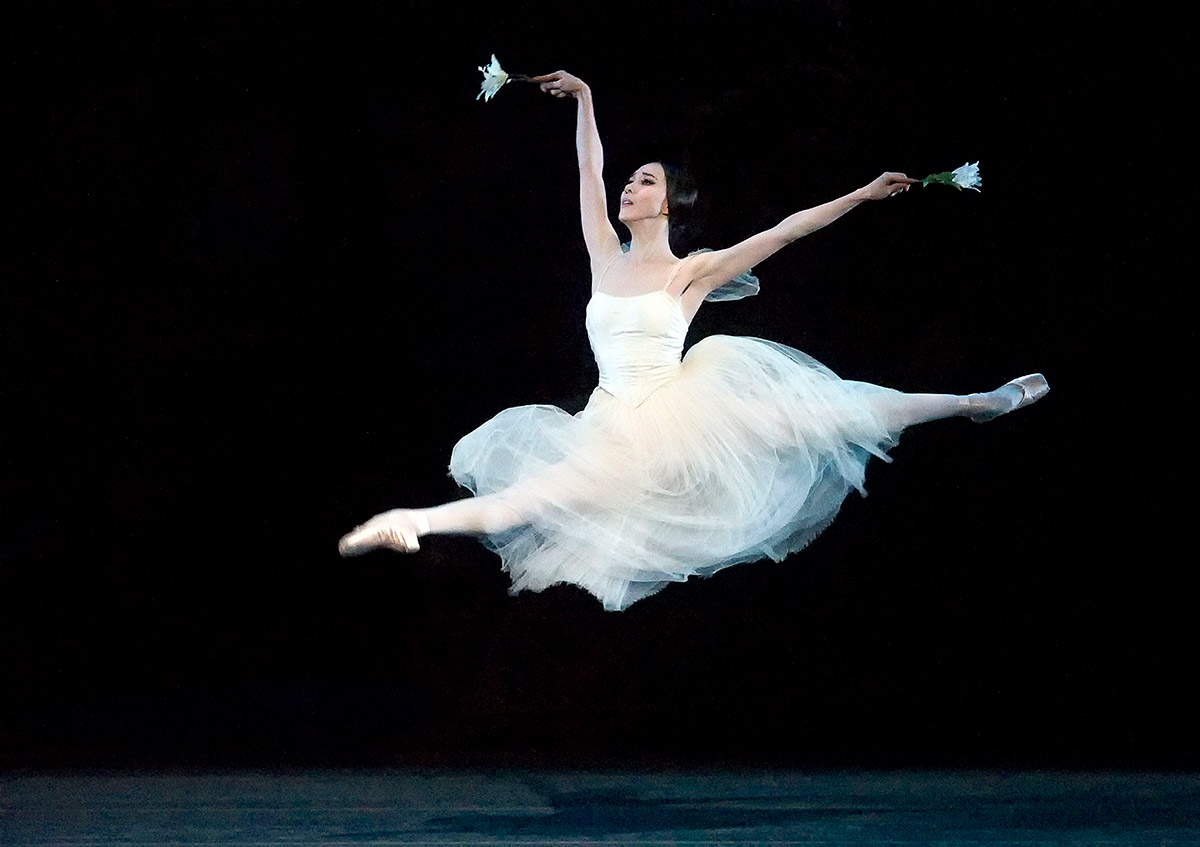
© Gene Schiavone. (Click image for larger version)
American Ballet Theatre
Giselle
★★★✰✰
New York, David H. Koch Theater
20 October 2021
www.abt.org
davidhkochtheater.com
Giselle Returns
As the American Ballet Theatre (ABT) artistic director, Kevin McKenzie, reminded us in a short curtain speech before the opening of the company’s fall season at the Koch Theater, it has been two years since ABT’s last performance in New York. And almost as long since a story ballet has been performed at Lincoln Center. The return of the company’s Giselle is a return to a kind of normalcy, even if the performance itself contained reminders that this time is anything but normal.
This was a safety-conscious Giselle, in which supernumeraries – the extras who fill out the village scenes – were eliminated, replaced by noticeably younger company-members. Some of the dancers in secondary roles, including the one performing Hilarion (Andrii Ishchuk), Giselle’s thwarted village suitor, wore masks. McKenzie had explained earlier that the masks were being worn “out of an abundance of caution.” But why some, and not all? Companies are doing what they can, coming up with their own protocols, but it was a bit of a head-scratcher.
This week, ABT performs no less than six Giselles, featuring as many casts, most of which contain débuts. Tuesday’s show, however, was led by a seasoned pairing, Hee Seo and Cory Stearns. Both tall and elegant, Seo and Stearns have danced together countless times. They guarantee a reassuring quality, a solid if somewhat generic understanding of the story and of the characters.
Seo, in particular, is lovely: delicate, willowy, vulnerable and shy in the first act, remote and sorrowful in the second. Her lines are as long and singing as ever and she has a wonderfully light jump. But her interpretation of the character comes in and out of focus. Her best dancing was in the allegro portions of the second act, in which the floating quality of her jumps imbued her Giselle airiness and energy. She added a pretty wrist undulation to a series of floating hops across the stage. Earlier, in the mad scene, she pointed the sword directly at her neck, a chilling gesture. Stearns, always an excellent partner, gave his Albrecht aristocratic haughtiness and command. But his dancing was underpowered – he may still be finding his stamina after the long break.
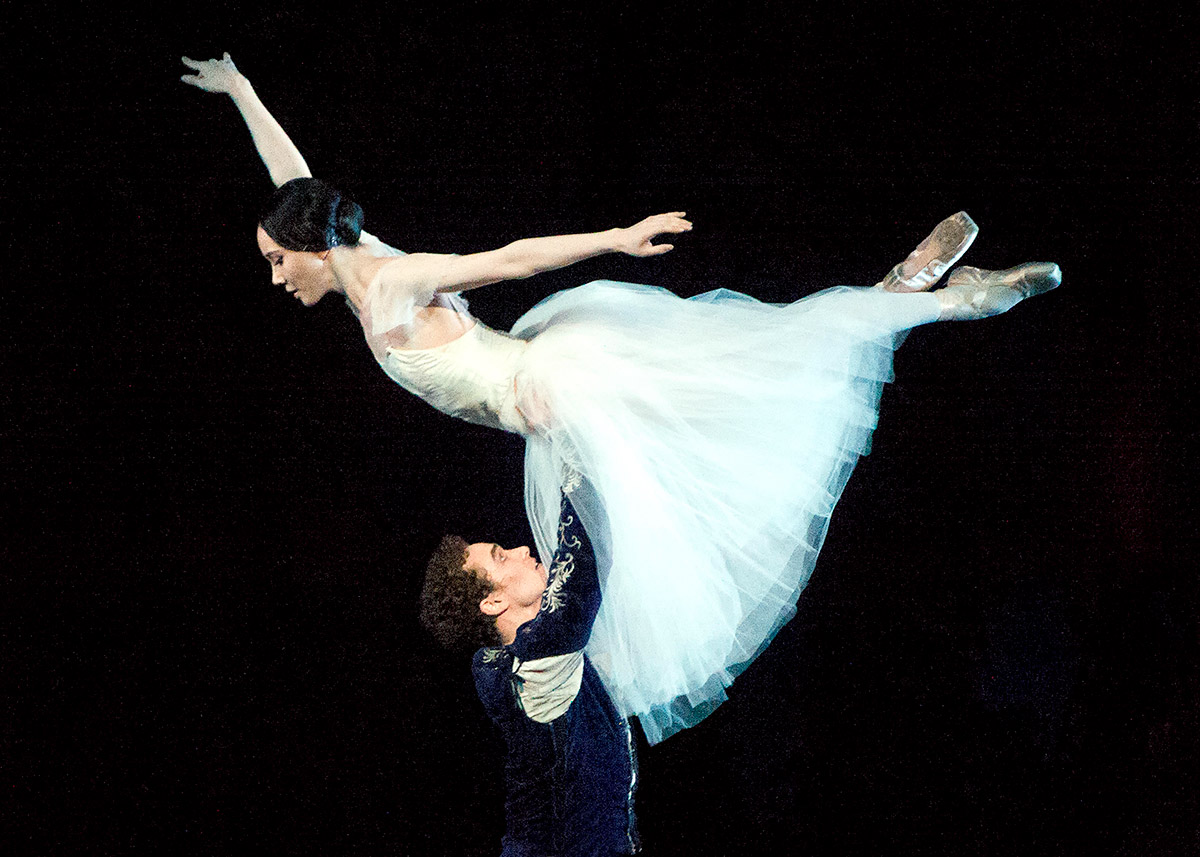
© Gene Schiavone. (Click image for larger version)
The evening found its footing as it progressed. The first act, with the exception of Katherine Williams in the “peasant pas de deux,” was a little pallid, as if the company were becoming reacquainted with the feeling of being onstage. Williams, in contrast, looked storng and confident.
The second act, with its poetic, sorrowful dances for the corps de ballet, paradoxically had more life. The moment in which the ensemble of female spirits, in their long diaphanous tutus, began swaying to the music, the ballet found its inner pulse. One of the pleasures of this company, especially after four weeks of New York City Ballet, is the three-dimensional way they use their backs and shoulders. Epaulement – the through-the-body twist of classical ballet – is something of a disappearing art. Not at ABT.
Some of the most exciting dancing of the evening came from Devon Teuscher, in the role of the queen of the spirits, or Myrta. Teuscher emerged from the wings with a string of tiny, smooth steps (bourrées) on pointe that made her appear to be gliding on a cushion of air. Her side-to-side tilts were excitingly off-balance, her jumps strong and sleek. I understand why she hasn’t been cast as Giselle this week – she’s not the classic waif-like dancer – but boy, would it be exciting to see her try.
Save for a few out-of-tune notes in the strings, the Adolphe Adam score cast its usual spell, setting the scene with alpine tunes and ghostly effects. Like Giselle itself, it tells the story in simple, clear terms. And sometimes that is enough.














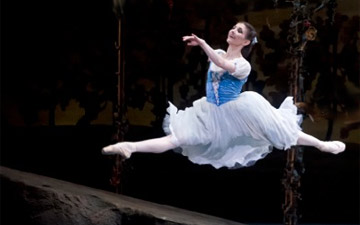
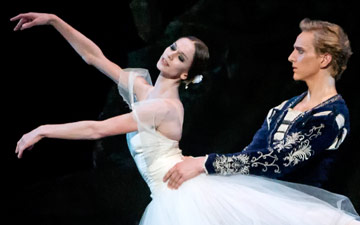
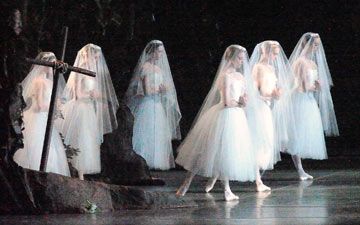
“I understand why [Devon Teuscher] hasn’t been cast as Giselle this week – she’s not the classic waif-like dancer – but boy, would it be exciting to see her try.”
I have a hard time believing that this comment was written by a professional dance critic—and a woman, no less. It is irresponsible of anyone—and especially someone who has influence over another woman’s career, particularly in the dance world—to use the term “waif” in reference to a woman’s body in either a comparative or contrasting light, positive or negative. Use of this term cannot be neutral. “Waif” is a historically loaded word, originally intended to describe a forsaken child, and more modernly, to describe women who evoke that imagery by being so skinny as to look malnourished. It was used in the 90s to praise models in the fashion industry who achieved the new and aptly coined “heroin chic” levels of skinniness, which we now know required eating disorders or substance abuse. The dance industry is especially plagued by body image shaming, with female dancers held to near impossible physical standards of thinness—a notable departure from what we accept of other professional female athletes. Whether intended or not, Harss’ comment implies that Teuscher was not given the lead role because she’s not thin enough—a female dancer’s worst nightmare and perhaps most harmful criticism for their mental health. Praising women for being disappearingly skinny is telling women that they should disappear—have no presence or power. When it comes to dance critique, let’s stop talking about women’s physical appearances and stick to technique.
Thank you for this!!! It’s most definitely overdue that dance professionals, from performers to instructors, be reviewed and praised for their technique, ability and artistic impression, not body size.
Dear Stephanie and Megan, Thank you both for your comments. I actually agree with both of you. My comment was actually meant to suggest that the “traditional,” conventional idea of how a dancer who performs Giselle should appear and what she should move like, probably inspired by the specific performances of Olga Spessivtseva and Alicia Markova – petite, delicate, a little mawkish, and, indeed waif-like — is too narrow, and should be widened to include dancers of all types, heights, techniques, and movement qualities. (My implication here is that in fact Devon Teuscher, a dancer I admire very much, should NOT be limited to Myrta, but should also, if she cares to, be able to dance the role of Giselle.) In my next review, of début casts in Giselle, to be posted soon, I express relief at seeing more of a range of dancers in the role. In both, I spend quite a bit of time discussing different interpretative and technical choices. So, I appreciate the thought..
Thank you for your reply, Marina—it is appreciated. Seeing as Kevin McKenzie has not shown an adherence to following the stereotype you mentioned in casting the role of Giselle (for example, Paloma Herrera, Gillian Murphy, and Christine Schevchenko), I don’t think it’s an accurate or fair assumption to make that Devon was not cast as Giselle because of her body type. Unfortunately, the comment unnecessarily calls attention to Devon’s body as a type that’s limiting, and Devon has written publicly about her struggles with body image. It also invites public comparison of different dancers’ bodies, which is a practice that continues to negatively impact dancers’ mental and physical health.
You describe the appearance of past Giselles as delicate and mawkish, and I contend that frailty was achieved through acting rather than actual physical feebleness, as professional dancers are anything but frail (I’m sure you agree). I also agree with you that Giselle should not be cast based on appearance at all. I think the best way to praise Devon and avoid the quagmire of body image would simply have been to say that you’d like to see her in the role. Thanks again for listening, and I look forward to reading your upcoming review!